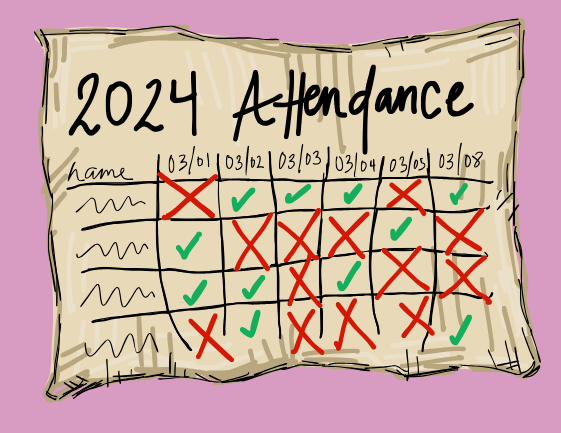Some names have been changed to protect students’ privacy.
Sophomore Sarah had two choices before going to school — she could go into class, completely unprepared for her test and probably fail. Or she could skip the test, take it on another day and likely get a better score. She could feel like a bad student, but not at the expense of her grades.
Whether it’s a poor grade or a missing assignment email from a teacher, the connotation of an “underachiever” follows students like Sarah throughout their high school careers. When balancing school, sports and social lives becomes too much, some look to absenteeism as a safety net.
Chronic absenteeism — when a student misses at least 10% of days in the school year — has risen in recent years throughout the nation. In Montgomery County, 35.8% of high school students were chronically absent in the 2022-2023 school year. In other words, nearly three in 10 students missed four or more weeks of school.
Numerous factors contribute to absenteeism. According to PBS, 12% of the nation’s students said that they feel too sad or depressed to attend school. These absence rates have a continuously diminishing effect on students and their school communities. U.S. Department of Education studies show that school absences impact test scores and educational engagement and damage relationships between students and teachers.
For many students academic pressure is a key factor in their choice to skip school. Because of its competitive environment, Whitman’s academic score — a rating that measures schools on academic proficiency — is higher than most others in Montgomery County. The Maryland State Department of Education (MSDE)’s Report Card shows that Whitman’s report card had an overall school performance of 77.9% based on indicators like academic achievement and graduation rate. In comparison, Gaithersburg High School had a 46.3% performance.
High expectations create extreme pressure and stress levels for students. Students sometimes attempt to combat this pressure by using absences as a coping mechanism, Science Teacher Peyton Ford said.
“There’s more pressure right now at this high school than a lot of other schools in the county,” Ford said. “Students are trying to manage their high school career when they have three, four tests on the same day.”
Recently, Whitman administrators announced a new assessment calendar that allocates specific days of the week to testing in different subjects, hoping to combat busy testing schedules. However, some students claim that it still permits teachers to assign up to four tests on the same day and that there are still ways teachers can work around the calendar by assigning large tests as quizzes in the gradebook.
“There are still tests in all my subjects in one week,” Sarah said. “Having to cram for all those tests in one week is very stressful and probably leads to most student absences.”
The return to in-person instruction after virtual classes during the COVID-19 pandemic is another main contributor to the rise in absenteeism. According to the US Department of Education, absences have almost doubled compared to absence rates before the pandemic. Remote learning helped students feel comfortable missing school while putting in minimal effort to attend classes. With the rise of cheating during the pandemic, remote learning simultaneously provided an easy way to get high grades.
However, online school’s slow-paced learning left many students struggling with the larger workloads and responsibilities once they returned to in-person learning. Academic burnout — where students face ongoing stress without time to relax — followed by the rebound of longer school days are directly attributable to recent absent rates. According to an NIH study, nearly 60% of high school students experienced academic burnout in 2023, contributing to the rise in absenteeism.
“Everything they teach you, you can learn online,” Sarah said. “So going to school doesn’t seem as beneficial as before and it’s become kind of useless.”
Student absences are irritating many Whitman teachers as they cause a disturbance on test days. When students miss tests, they often reassess during lunch periods, which extends the grading process up to three or four days, Ford said. Reassessing after school or during lunch can also take time away from teachers’ review periods. At the same time, teachers feel responsible for supporting chronically absent students, said Math Teacher Michelle Holloway.
“You always have to be empathetic,” she said. “It could be anxiety about school, it could be an illness [or] it could be just a mental health issue overall.”
According to Holloway and Ford, teachers can see if students were marked absent for other classes through the teacher portal in Canvas — an Instructure software used to manage course content and online teaching. If they notice a student is only absent during a testing period, they could deduct points from the student’s exam.
While there are ways to tell if a student skips a test, there are few consequences if a student does not attend school regularly. Parents can send an absence email to the main office at Whitman, allowing an easy excuse for their children’s absences. Ford explained that when he attended high school in Fairfax County, any unexcused absence succeeding the limit per year meant deducting a letter grade. Although their absences are marked as unexcused if the main office isn’t informed, the lenient system for parent excuses can often allow students to skip school without many consequences. Sarah explains this is what contributes the most to her chronic absenteeism.
“There aren’t any repercussions to skipping and I’m always really tired,” she said. “It just feels like there’s no longer any point in going.”
















